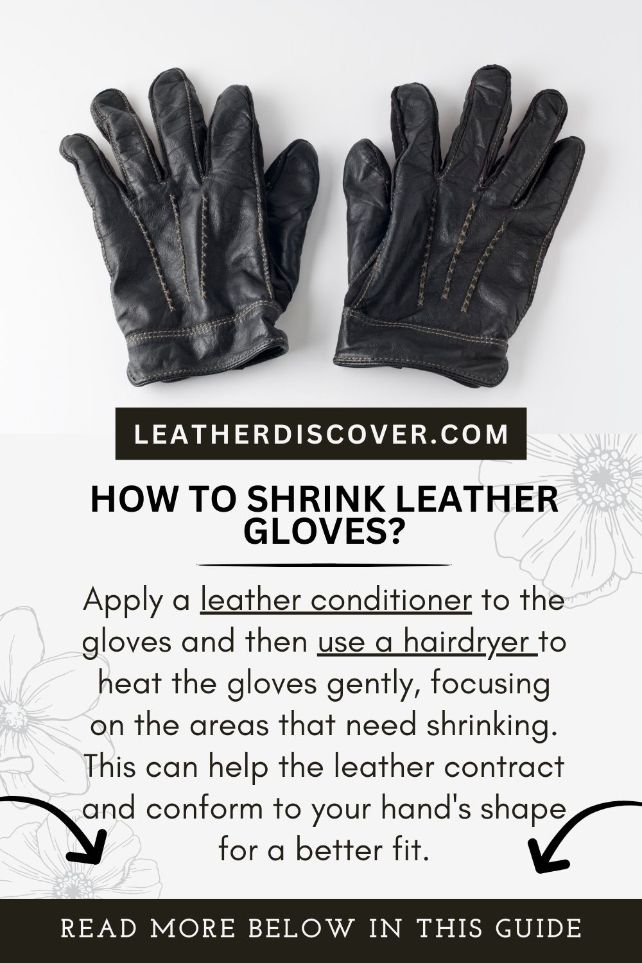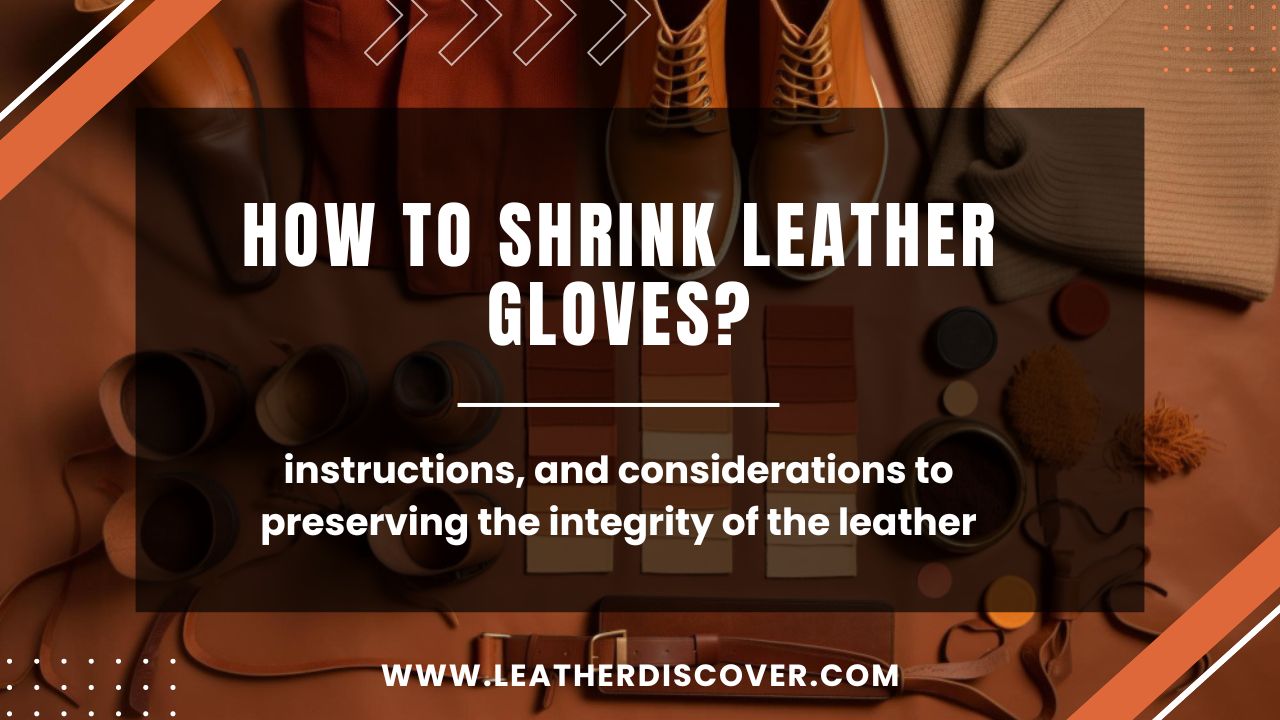Leather work and motorcycle gloves can expand with use as repeated hand flexing and sweat absorption cause the collagen fibers to relax. When the palm and finger compartments begin to deform, the glove loses structural tension, reducing grip security and hand alignment during riding or manual tasks.
Shrinking these gloves involves controlled fiber contraction through warm water exposure or localized heat curing. By carefully tightening the grain layers and then restoring moisture balance with conditioning oils, the leather can regain a fitted shape without surface cracking or stiffness, ensuring both protection and flexibility remain intact.
We’ll cover everything you need to know to make sure your gloves fit perfectly and stay in great condition.
Let’s get started and fix those loose gloves!
[toc]

How to Shrink Leather Gloves?
Shrinking leather gloves can be a bit tricky, but with the right approach, you can achieve a better fit. Here’s how I’ve managed to shrink leather gloves effectively:
1. Assess the Fit:
First, assess how much you need to shrink the gloves. Put them on and note where they feel loose or too large. This will guide your shrinking strategy.
2. Soak the Gloves:
Fill a basin with lukewarm water. Submerge the gloves completely, ensuring they are soaked through. Leather absorbs water, which helps in shrinking. I’ve found that soaking them for about 10-15 minutes works well.
3. Remove Excess Water:
After soaking, gently squeeze out excess water from the gloves. Avoid wringing them, as this can damage the leather. Instead, press them between towels to absorb moisture.
4. Wear the Gloves to Dry:
Put the damp gloves on your hands and wear them until they dry completely. As the leather dries, it will conform to the shape of your hands, shrinking slightly in the process. This method allows for a more custom fit. Just be prepared for them to feel a bit tight initially.
5. Use a Hairdryer (Optional):
If you need quicker results or want to target specific areas, you can use a hairdryer on a low heat setting. Hold the dryer a few inches away from the gloves and move it around to evenly distribute the heat. Keep wearing the gloves as you dry them to maintain the shape.
6. Apply Leather Conditioner:
Once the gloves are dry and you’re happy with the fit, apply a leather conditioner to keep the leather supple and prevent it from becoming brittle. This step is crucial for maintaining the quality of the leather over time.
Personal Tips: From my experience, patience is key when shrinking leather gloves. Rushing the drying process or exposing them to high heat can damage the leather or cause it to shrink unevenly. Also, remember that leather naturally stretches over time, so a slightly snug fit initially is preferable to gloves that become too loose later on.
By following these steps and being mindful of the leather’s natural properties, you can effectively shrink your leather gloves to achieve a comfortable and personalized fit.
Do Leather Gloves Shrink or Stretch Over Time?
Leather gloves can experience both shrinkage and stretching over time. The extent to which this occurs depends on several factors, including the type of leather, the quality of the gloves, and how they are cared for.
1. Shrinkage Over Time:
Leather gloves may experience slight shrinkage over time, particularly if they are exposed to moisture, such as rain or sweat, and then dried repeatedly.
This is because leather can lose some of its natural oils and become less pliable with prolonged exposure to moisture and heat.
2. Stretching Over Time:
On the other hand, leather gloves can also stretch with regular wear. This is especially true for soft leather gloves.
As you wear them, the leather gradually conforms to the shape of your hand, resulting in a more comfortable and custom fit.
Aftercare: Conditioning and Long-Term Maintenance
Shrinking removes some of the glove’s natural oils, making post-treatment essential to restore flexibility and prevent drying or cracking.
Conditioning After Shrinking
-
Apply a small amount of leather conditioner or balm.
-
Massage it slowly into the surface using circular motions.
-
Let the gloves rest for several hours to absorb nourishment.
Avoid petroleum-heavy products, which can clog the grain or leave a greasy finish. Natural conditioners with lanolin or beeswax work best.
Maintaining Shape After Resizing
-
Insert glove shapers, soft paper, or cotton fabric inside each finger.
-
Lay the gloves flat on a ventilated surface, away from direct heat sources.
-
Do not fold or stack the gloves while they are still drying.
Storage Practices for Longevity
-
Store in breathable cloth pouches, not plastic bags.
-
Keep away from direct sunlight or damp environments.
-
Condition every few months to retain suppleness.
Precautions and Common Mistakes to Avoid
Improper technique can result in irreversible damage, color loss, or hardened leather. Awareness of common errors preserves glove quality.
|
Issue |
Cause |
Solution |
|
Leather too tight |
Excessive shrinking |
Apply conditioner, stretch gently by hand |
|
Uneven fit |
Selective soaking |
Spot spray and re-shape while wearing |
|
Hard or stiff texture |
Overheating |
Massage with warm conditioner |
|
Lining wrinkles |
Full soaking on lined gloves |
Use targeted drying only |
Conclusion:
Shrinking leather gloves is a careful balance of restoring fit without harming the glove’s structure. With controlled use of water, heat, and proper conditioning, leather fibers can safely contract back to form, improving grip and hand control. When done patiently and monitored closely, even stretched work or motorcycle gloves can regain their original shape, ensuring comfort, durability, and performance remain intact.
- What Is Caiman Leather? A Detailed Guide - July 25, 2024
- What Is Tumbled Leather?A Complete Guide - July 25, 2024
- What Is Kip Leather? Premium Leather Choice - July 24, 2024

